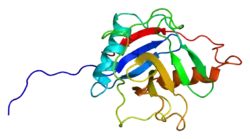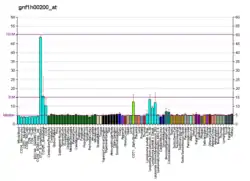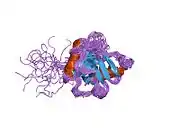PPIL1
Peptidyl-prolyl cis-trans isomerase-like 1 is an enzyme that in humans is encoded by the PPIL1 gene.[4][5][6]
This gene is a member of the cyclophilin family of peptidylprolyl isomerases (PPIases). The cyclophilins are a highly conserved, ubiquitous family, members of which play an important role in protein folding, immunosuppression by cyclosporin A, and infection of HIV-1 virions.
Based on similarity to other PPIases, this protein could accelerate the folding of proteins and might catalyze the cis-trans isomerization of proline imidic peptide bonds in oligopeptides.[6]
References
- GRCh38: Ensembl release 89: ENSG00000137168 - Ensembl, May 2017
- "Human PubMed Reference:". National Center for Biotechnology Information, U.S. National Library of Medicine.
- "Mouse PubMed Reference:". National Center for Biotechnology Information, U.S. National Library of Medicine.
- Mann SS, Pettenati MJ, von Kap-herr C, Hart TC (Mar 1999). "Reassignment of peptidyl prolyl isomerase-like 1 gene (PPIL1) to human chromosome region 6p21.1 by radiation hybrid mapping and fluorescence in situ hybridization". Cytogenet Cell Genet. 83 (3–4): 228–9. doi:10.1159/000015186. PMID 10072585. S2CID 85413695.
- Ozaki K, Fujiwara T, Kawai A, Shimizu F, Takami S, Okuno S, Takeda S, Shimada Y, Nagata M, Watanabe T, Takaichi A, Takahashi E, Nakamura Y, Shin S (Jan 1997). "Cloning, expression and chromosomal mapping of a novel cyclophilin-related gene (PPIL1) from human fetal brain". Cytogenet Cell Genet. 72 (2–3): 242–5. doi:10.1159/000134199. PMID 8978786.
- "Entrez Gene: PPIL1 peptidylprolyl isomerase (cyclophilin)-like 1".
Further reading
- Tripodis N, Mason R, Humphray SJ, et al. (1999). "Physical map of human 6p21.2-6p21.3: region flanking the centromeric end of the major histocompatibility complex". Genome Res. 8 (6): 631–43. doi:10.1101/gr.8.6.631. PMC 310739. PMID 9647638.
- Lai CH, Chou CY, Ch'ang LY, et al. (2000). "Identification of novel human genes evolutionarily conserved in Caenorhabditis elegans by comparative proteomics". Genome Res. 10 (5): 703–13. doi:10.1101/gr.10.5.703. PMC 310876. PMID 10810093.
- Jurica MS, Licklider LJ, Gygi SR, et al. (2002). "Purification and characterization of native spliceosomes suitable for three-dimensional structural analysis". RNA. 8 (4): 426–39. doi:10.1017/S1355838202021088. PMC 1370266. PMID 11991638.
- Strausberg RL, Feingold EA, Grouse LH, et al. (2003). "Generation and initial analysis of more than 15,000 full-length human and mouse cDNA sequences". Proc. Natl. Acad. Sci. U.S.A. 99 (26): 16899–903. doi:10.1073/pnas.242603899. PMC 139241. PMID 12477932.
- Clark HF, Gurney AL, Abaya E, et al. (2003). "The secreted protein discovery initiative (SPDI), a large-scale effort to identify novel human secreted and transmembrane proteins: a bioinformatics assessment". Genome Res. 13 (10): 2265–70. doi:10.1101/gr.1293003. PMC 403697. PMID 12975309.
- Mungall AJ, Palmer SA, Sims SK, et al. (2003). "The DNA sequence and analysis of human chromosome 6". Nature. 425 (6960): 805–11. Bibcode:2003Natur.425..805M. doi:10.1038/nature02055. PMID 14574404.
- Gerhard DS, Wagner L, Feingold EA, et al. (2004). "The status, quality, and expansion of the NIH full-length cDNA project: the Mammalian Gene Collection (MGC)". Genome Res. 14 (10B): 2121–7. doi:10.1101/gr.2596504. PMC 528928. PMID 15489334.
- Xu C, Xu Y, Tang Y, et al. (2005). "Backbone and side chain assignments of human Peptidylprolyl Isomerase Like 1 (hPPIL1)". J. Biomol. NMR. 31 (2): 179–80. doi:10.1007/s10858-004-8238-0. PMID 15772761. S2CID 30456850.
- Xu C, Zhang J, Huang X, et al. (2006). "Solution structure of human peptidyl prolyl isomerase-like protein 1 and insights into its interaction with SKIP". J. Biol. Chem. 281 (23): 15900–8. doi:10.1074/jbc.M511155200. PMID 16595688.
This article is issued from Wikipedia. The text is licensed under Creative Commons - Attribution - Sharealike. Additional terms may apply for the media files.




